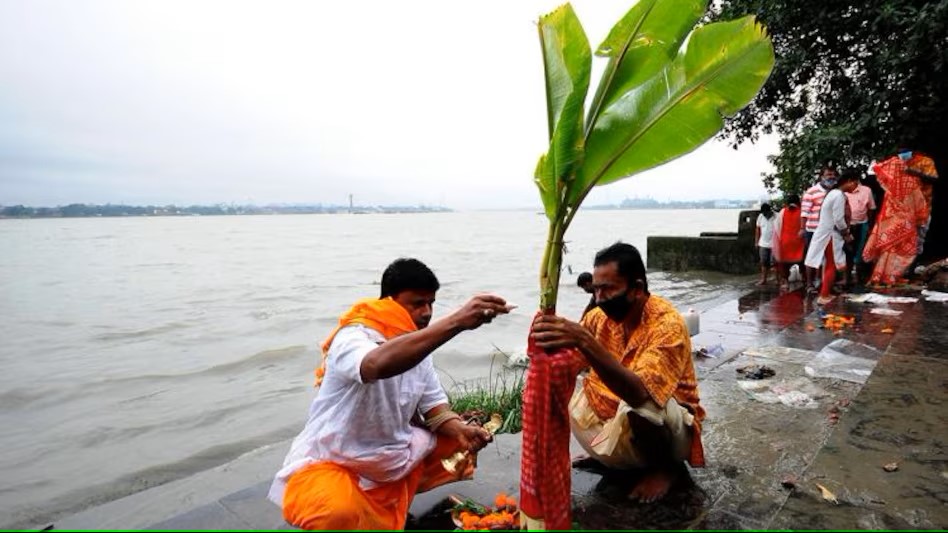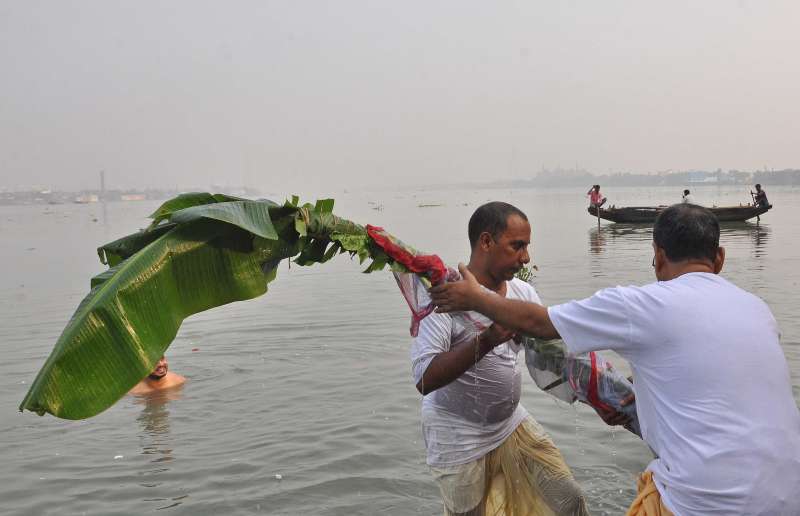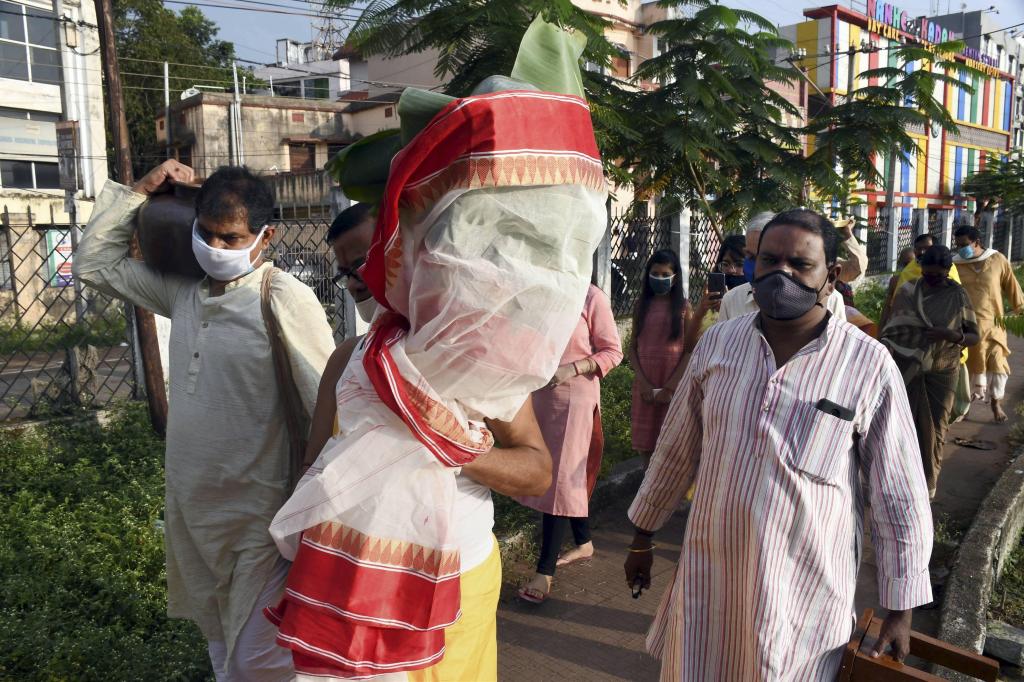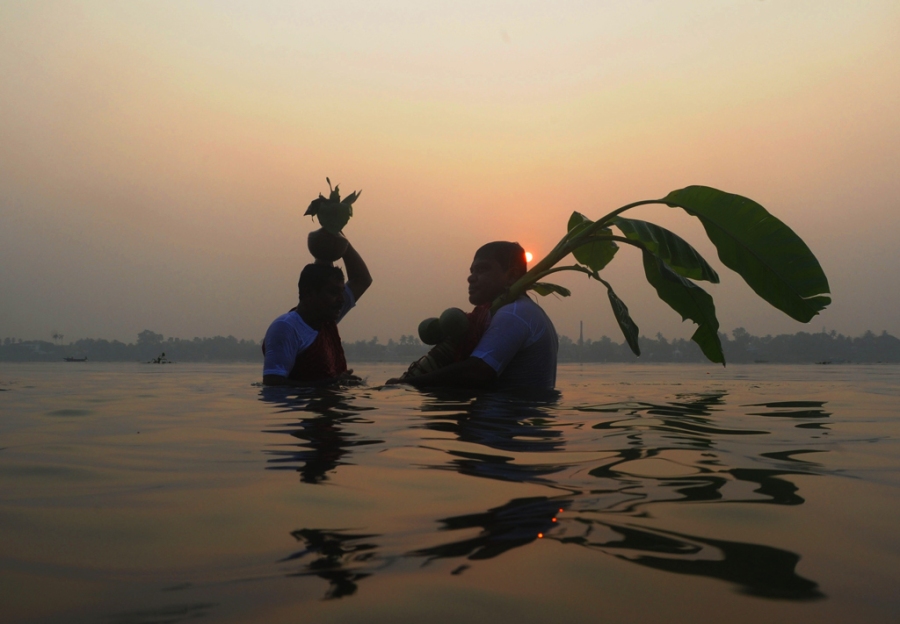Nabapatrika is an important ritual enthusiastically observed by the Bengali community. This distinctive tradition entails the veneration of nine distinct plants, collectively referred to as Nabapatrika. The ritual marks the beginning of the Durga Puja festival, which is also known as Durgotsav. Nabapatrika, also known as Nabapatrika or Nabapatra, is a significant ritualistic emblem in the celebration of the festival of Durga Puja. The term “Nabapatrika” translates to “nine leaves” in the Bengali language, representing nine different plants or trees.
Durgotsav also marks the harvest season, a season of health, wealth and prosperity. Apart from being a religious festival, it is also an occasion for reunion, rejuvenation and celebration of traditional culture and customs. The festival culminates on the tenth day, which is celebrated as Vijayadashami or Dussehra.
From time immemorial Mother Goddess was a popular deity in the ancient world. The conception of Motherhood of the Supreme being that manifested in female form is perhaps the finest expression in Hinduism. It is the ascendance of the maternal principle over the male Gods who yielded their major symbols, weapons and power so the whole might be amalgamated into an omnipotent totalization of cosmic forces.
Bengalis prefer to believe that this is the time when Goddess Durga arrives at her parental home on earth from her bridal home in Mount Kailash. And she arrives with her children in tow — Ganesh, Kartik, Lakshmi and Sarasvati.
There are many beliefs, myths, legends, folktales, and rituals attached to this Bengali festival and one of them is the Nabapatrika (nine leaflets mostly tied together).
During the Nabapatrika ritual, nine different plants or trees are gathered and bundled together. These plants are representative of the nine different forms of Goddess Durga. These plants are tied together with a sacred thread and are placed on a pedestal for worship. The Nabapatrika is then bathed in holy water and is offered various puja items like flowers, fruits, sweets, and incense sticks.

On the early hours of Saptami, the seventh day, Goddess Durga is invoked in a group of nine plants bunched together, called Nabapatrika, and tied to the twigs of white Aparajita plant (Clitoria ternatea) with a yellow thread. The Nabapatrika worship is believed to be an ancient tradition. It is said that the nine plants represent the nine forms of Goddess Durga, who is worshipped during the Durga Puja festival. The nine plants of Nabapatrika represent nine Goddesses:
- Banana plant (কদলী বা রম্ভা): Goddess Brahmani
- Colocasia plant (কচু): Goddess Kalika
- Turmeric plant (হরিদ্রা): Goddess Durga
- Jayanti plant (জয়ন্তী): Goddess Kartiki
- Bel leaves (বিল্ব): Goddess Shiva
- Pomegranate leaves (দাড়িম্ব): Goddess Raktadantika
- Asoka leaves (অশোক): Goddess Shokarahita
- Arum plant (মানকচু): Goddess Chamunda
- Rice paddy (ধান): Goddess Lakshmi
The Nabapatrika is given a pre-dawn bath in river/pond water. Mantras are chanted through the bathing ritual. After the bathing ceremony, Nabapatrika is adorned in red-bordered white sari and vermilion is smeared on its leaves. She is then placed on a decorated pedestal and worshipped with flowers, sandalwood paste and incense sticks. Later she is placed on the right side of Lord Ganesh. This is the reason she is also popularly known as Ganesh’s wife — Kolabou.
Bengalis love to believe the gods and goddesses as one of them, their family members, or as fellow villagers. There is an interesting folktale related to Kolabou.
According to the folktale, the wedding procession of Ganesh had not gone very far from home, when Ganesh remembered that he had forgotten something. On returning, he found his mother Durga eating bowlfuls of rice and gorging herself. Ganesh found it odd and asked his mother, why was she gorging herself. To this Durga is supposed to have said – “Jodi tor bou aamaake khete na daye?” (What if your wife did not give me enough food to eat?). Hearing this Ganesh was upset, he stepped out of his home, cut a banana tree and gave it to her saying “etai tomar bou” (this is your daughter-in-law). Later, Ganesh was married off to the banana tree and thus the name Kalabou, or the banana bride.

Earlier the bathing ritual of Nabapatrika was an elaborate affair for the rich landlords and traders of Bengal. Long processions accompanied by musical instruments and much fanfare were common then. With idol worship gaining ground, nabapatrika slowly lost its importance.

Nabapatrika was a popular ancient ritual performed by the peasants/farmers worshipping Mother Nature for a rich and bountiful harvest. It is a symbol of fertility. A symbol of the ‘mother’. With the popularity of the Durga Puja, this ritual was assimilated into the festivities. Nabapatrika has no reference in Vedas or in the Puranas. The earliest reference could be found in the Krittivasi Ramayan, composed by 15th-century Bengali poet Krittibas Ojha, a rendition of the Ramayana in Bengali. This important ritual of Durga Puja is an example of inclusiveness — a harmonious synthesis of Vedic and ancient non-Vedic rituals.

Many scholars have even opined that the Nabapatrika is a form of Durga herself, which symbolizes all the aspects of nature in a complex vegetative state. According to a scholar, the plant symbolizes the “festive enactment of Durga’s return of the blood of the buffalo demon to the earth so that the order of the world be re-established and luxuriant vegetation appears.”

As we cry for climate change and the environment, here is the highest form of regard for the environment where the goddess is worshipped in the forms of plants. The Nabapatrika ritual holds great cultural and religious significance in the Durga Puja festivities, representing the power and glory of the goddess and the cyclical nature of life. It is a vibrant and integral part of the rich traditions and customs associated with Durga Puja in Bengal. This ritual not only celebrates the power of nature but also promotes unity and harmony among people.


Wow dad. Beautiful and elaborate information. Quite filling.
LikeLiked by 2 people
Thanks, beta. 🙂
LikeLiked by 1 person
Very informative… I remember seeing the Nabapatrika bathing procession in some Bong movie… The village zamindar along with his subjects taking out elaborate congregation… Can’t remember the name of the movie…
LikeLiked by 3 people
Thanks, Aro. Many traditions are getting lost or diluted under the influence of our modern, instant lifestyle.
LikeLike
Thanks for sharing, this information was something new for me.
LikeLiked by 1 person
Thanks, Arvind.
LikeLiked by 1 person
Very informative post. Thanks for the list of nine plants in Nabapatrika.
LikeLiked by 2 people
Thanks, Nilanjana.
LikeLike
beauty, v informative ,have no idea about nabpatrika.n nabpatrika is a form of Durga
thnx 2 share a lovely post
LikeLiked by 1 person
Thanks, Nitin.
LikeLike
Was not aware of this.
LikeLiked by 2 people
Informative indeed. Kolkata’s Banedi Bari’s (traditionally rich) pujos used to celebrate Nabapatrika snan with lots of fanfare. Rani Rashmoni’s husband constructed a road towards Ganga river just for Nabapatrika bathing!!
LikeLiked by 3 people
Yes, you’re right. Thanks, Mano.
LikeLike
Very interesting and informative! Thank you
LikeLiked by 1 person
Thanks, Nandini.
LikeLike